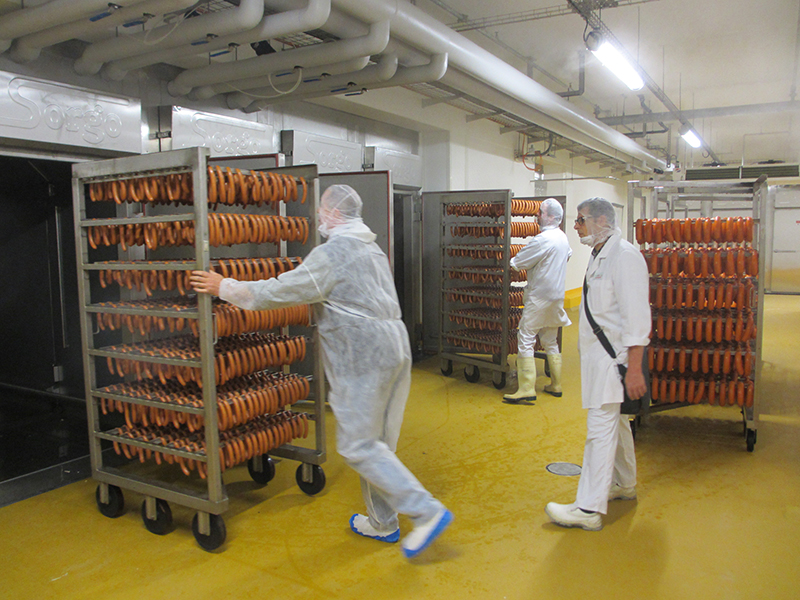
Elaborate combination
Due to modernisation measures at their production location in Kempten, the food retailer Feneberg was restructuring their entire sausage production step by step. Because of these measures, the company was also looking for a plant builder that could offer an adequate solution for the production of their diversified assortment of sausages.
Feneberg Lebensmittel is a local retail chain with their headquarters in Kempten. The retailer runs 14 consumer markets and 64 supermarkets in the South German regions of Allgäu, Upper Swabia and Upper Bavaria. The company structure includes Feneberg Markets, Kaufmarkt Markets as well as meat and bakery goods producing plants. Additionally, Feneberg offers restaurants, system gastronomy operations and catering services. Since the company’s foundation by Theodor Feneberg in 1947, the retailer has been family-run and attaches much importance to fresh and regional products. This stance is reflected in the range of meat and sausage products. Brand programs such as PrimaSchwein (pork), PrimaKalb (veal) and PrimaRind (beef) focus on establishing close ties with contract farmers in Bavaria and Baden-Württemberg.
Optimised processes
Firm roots in the region and the production of traditional products have always been part of the company’s identity. Correspondingly, the range of traditional sausage and ham specialities is very extensive and includes more than 150 products altogether. These types of products are produced centrally at the company location in Kempten, from where they are delivered to the branches.
Since two years, Feneberg has been modernising this location in order to make production processes more effective. The smoking area has also been a part of these measures. Although the existing units have only been used for ten years, Feneberg decided to invest in new treatment units that would allow to create optimum production structures. Therefore the company was looking for a plant builder that could offer a satisfying solution. “We started by making an exact analysis of our processes and of our product structure,” Herbert Lupper, Production Engineer at Feneberg, explains. “In the future, we wanted to process larger batches because we switched from an order to a stock-based production.” To this end, the company has already built a large automatic warehouse including commissioning. Ideal climatic conditions allow for products to be produced up to four days in advance. Naturally, this also affects the structure of the smoking and cooking units. “In the following call for bids we deliberately restricted our project description to these basic conditions and left a certain scope for interpretation,” Herber Lupper specifies. “We wanted to see the differences in the offers we received and expected precise proposals from the experts.”
After an extensive decision making process and intense talks, the Austrian plant builder Sorgo convinced Feneberg with their solution. This decision was also supported by many excellent references. “We visited existing customers of Sorgo and saw the units in operation. Both customers stated that they would always buy a treatment unit from this manufacturer again,” Herbert Lupper recalls. “I thought to myself that I won’t make a wrong choice if a manufacturer has such a good reputation.” Another feature in favour of Sorgo was the fact that the company is also owner-managed, which makes it more simple to communicate across all hierarchical levels.
Flexible plant-mix
For the production of different types of scaled, cooked and raw sausages, Sorgo suggested a mix of hot-smoking, cooking and intensive cooling units as well as an innovative hygienic design. “Due to the diversified product range we could exclude half-continuously operating units. Batch units are much more flexible in this case,” Joachim Gensle from Sorgo Anlagenbau explains. The chambers are designed as tunnels and function as door-to-door system with an interlocking system. Both sides can be interlocked, which means that a contamination of the high-risk end can be ruled out. “The mix of hot-smoking and intensive-cooling units has a significant advantage with regard to hygiene: especially when scalded sausages are produced, the risk of microbiological contamination can be significantly reduced because the sausages are cooled directly after the smoking process,” Joachim Gensle explains.
Sorgo estimated and reliably kept an installation period of eight weeks. “Following technical commissioning, there were only two weeks left to run test batches since the Christmas season was coming up”, Herbert Lupper recalls. A process engineer from Sorgo was on site and made the necessary adjustments. “The programming was completed very swiftly and we immediately achieved good results”. Although Feneberg kept the old units operational as a safety precaution, the entire production volume could be processed in the new treatment units.
Uniform quality
That it was the right decision to choose Sorgo was now also confirmed by the butchers and not least by the customers of the retail branches. “The quality of our products has been improved by the new units. This is also due to the fact that we changed the smoking method and now only use friction smoke generators. Before that, we had used different smoking methods,” says the Production Engineer.
Feneberg also attached much importance to the quality of the fresh air, which is for instance required to dry sausages: Feneberg provided a sample of fresh air in the desired quality. In this way Sorgo was able to create uniform conditions within each treatment chamber ensuring a certain degree of product standardisation. Now it is also possible to process all types of products in different units and achieve reproducible qualities. “The supply of fresh air and its effect on product quality are often neglected,” says Joachim Gensle and adds: “The programme parameters in unit one work just as fine in unit four.” This means that the food producer is able to plan production processes more flexibly.
The combination of cooking and intensive cooling in the same unit brings more flexibility, but most of all results in reduced handling efforts. “By combining both methods in one unit, we are now able to run cooking and cooling processes over night. We just activate a nigh start sequence and in the morning the products have the desired temperature for subsequent packaging or commissioning.”
Considering the treatment of their raw sausages, Feneberg also had a clear idea with regard to uniformity and weight loss. By means of horizontal and vertical air circulation inside the climatic-treatment and cold-smoking units, Sorgo was able to fulfil these demands easily. “The parameters that are important for our customers are considered in the programming stage. If necessary our technician suggests improvements,” says Joachim Gensle.
Finally, cooking kettles with a special modification completed the project realised by the plant builder. An automatic lid opener ensures ergonomic and easy operation.
Hygiene on a stable basis
A further feature of the concept designed by Sorgo is an innovative hygienic design. It is almost unavoidable that dirt settles underneath the treatment units and it cannot be removed anymore. Therefore, the plant builder came up with a special solution: The units are standing on feet, which makes it easy to clean them underneath. Soon this will be done automatically by means of nozzle holders supplied by Sorgo.
During the entire project, Sorgo was able to meet Feneberg’s demands with sophisticated details and innovative ideas – from the planning stage through to initial operation. “Even after initial operation is completed, we provide after-sales services. There is no limited service period. If for instance the customer wants to add a new product to his range, we will help in programming the right parameters”, concludes Joachim Gensle.

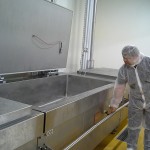
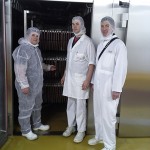
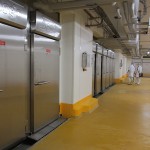
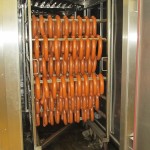
0 Comments